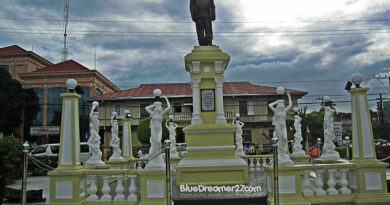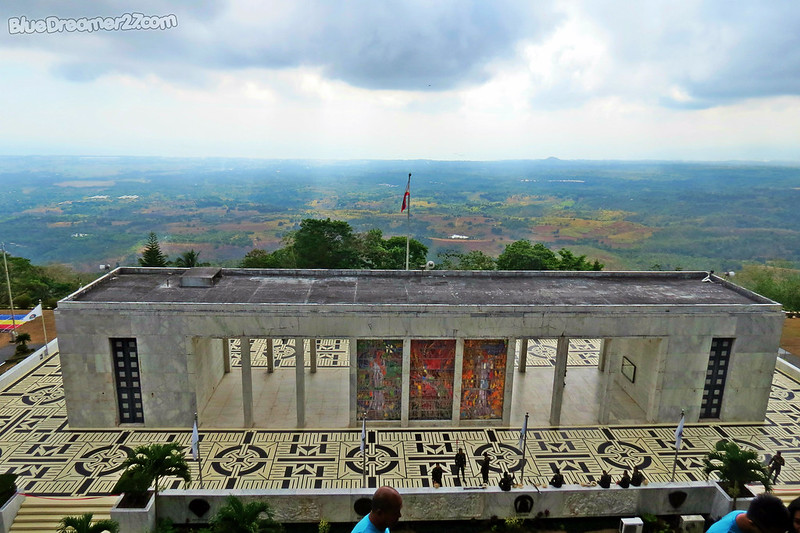11 Eerie Artworks in National Museum of Fine Arts That You Should See
In celebration of the International Museum Day, we’re looking back to my recent visit to National Museum of Fine Arts. This time, however, we’re listing down ten of eerie artworks that are currently displayed in National Museum of Fine Arts. Please take note that this list is created subjectively and it doesn’t intend to disrespect the artists or devalued their masterpieces. Art can be seen as a reflection of the artists subconscious which is also a reflection of their environment. Some paintings can be eerie and enigmatic because the artists channel their emotion and the feelings they want to express when making the artwork.
Here’s the list of ten eerie artworks in National Museum of Fine Arts
1. Recuerdo De Patay(Memento Mori) of a Child by Simon Flores Y Dela Rosa
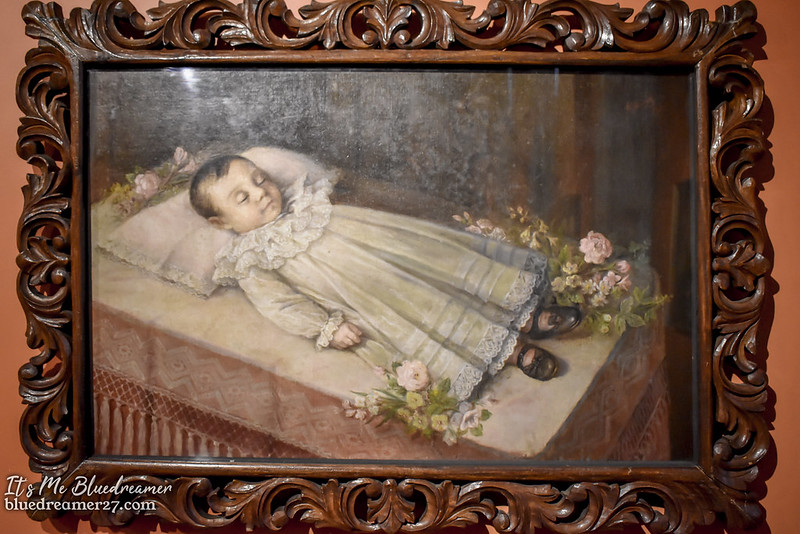
Located in Gallery IV of the National Museum of Fine Arts is a huge collection of portraits. Most of these portraits convey self-representation, aspiration, and likeness, among other desires and projections that characterize 19th century portraits found in the Philippines. One of the painting that will surely catch your eye is a portrait of a deceased child. This practice is known as Recuerdo de Patay or Momento Mori. This type photography was very common in the 19th century when death occurred in the home and was quite an ordinary part of life. Due to photography being a new medium, it is plausible that many post-mortem portraits, especially those of infants and young children, were probably the only photographs ever made of the ‘sitters.’ Post-mortem photography flourished in photography’s early decades, among clients who preferred to capture an image of a deceased loved one rather than have no photograph at all
The painting in National Museum is a masterpiece of Simon Flores y De la Rosa, one of the country’s eminent portraitists. Completed in 1896, this oil painting of an infant seemingly in deep sleep that may have been commissioned during her funeral as the family’s memento mori.
2. Mi Novia – Painting of a Lady by Juan Luna

The Gallery VI of the Museum highlights the art works of both Juan Luna and Felix R. Hidalgo and in this hall lies the infamously known as the cursed painting of Juan Luna. Interestingly, the painting comes with multiple titles. It is known as “Mi Novia” which literally translates as “My Girlfriend”. The portrait portrays a woman in bed. Her clothes are dropping and she is holding a rosary. A prayer book sits next to her. It evokes sensuality and innocence with its delicate brushstrokes that evokes an emotional response from the viewer. It also holds the title “Painting of Paz Pardo de Tavera” which clearly points out that the woman in the painting is Juan Luna’s wife.
Juan Luna killed Paz and his mother-in-law in their home 23rd of September 1892. Luna was known to be very fond and possessive of his wife. He accused Paz of having an affair with a certain Monsieur Dussaq. His anger and jealousy got the best of him and shot Paz and his mother-in-law. The painting was said to be cursed as Juan Luna was currently working on it when he killed his wife. It is said that Paz’s soul possessed the painting and brings terrible luck to whoever owns it. The last owner was Imelda Marcos before donating the portrait to National Museum.
However, some accounts state that the woman in the painting was not Paz. It is said to be Angela Duche who is also the same woman in Juan Luna’s “The Parisian Life” painting. From Mi Novia, the painting was later renamed simply as “Portrait of a Lady”
3. La Barca de Aqueronte by Felix Ressureccion Hidalgo

On the same gallery, you’ll find yet another eerie masterpiece. This time, it is the “La Barca de Aqueronte” or the “Charon’s Boat” by Felix Resurreccion Hidalgo. Hidalgo is known for his neoclassical style paintings and Charon’s Boat is considered to be his most awarded work of art. Inspired by the artist’s reading of Dante’s “Inferno,” the oil-on-canvas painting shows nude figures in agony or the souls of the damned as they are ferried across the River Acheron and into the underworld by boatman Charon, a solitary figure on the other side of the scene.
In this version, Charon is seen wearing a dark cloak and with an oar that almost looks like some sort of weapon. The look that he has is cruel and commanding. There is also another version of the painting displayed in Lopez Museum where Charon is depicted as a naked man. The painting in National Museum is also notably placed on an intricately detailed carved wooden frame.
4. Doomed Family by Dominador Castañeda
 Gallery VIII is probably the eeriest halls in the museum. The gallery features paintings and artworks related to the events of the Second World War. Take note that most of the paintings in this gallery contains graphic images that may be disturbing to some viewers. Doomed Family by Dominador Castañeda is one of the most disturbing portraits in the gallery.
Gallery VIII is probably the eeriest halls in the museum. The gallery features paintings and artworks related to the events of the Second World War. Take note that most of the paintings in this gallery contains graphic images that may be disturbing to some viewers. Doomed Family by Dominador Castañeda is one of the most disturbing portraits in the gallery.
The artwork was painted in 1945 during the Japanese invasion in the country. This painting conveys the idea of what Japanese did to the Filipino family, and many people have died during their time. It shows a mother lying on the floor bathing in her own blood. Her breast is exposed through a ripped shirt alluding to her rape. Her husband is bound; his back shows signs of being tortured. A child sits before him bound and screaming as she looks out towards their torturers. They are bathed in warm light presenting them as innocents or martyrs subjected to unrestrained cruelty.
5. Ravaged Manila by Dominador Castañeda

Also painted by Dominador Castañeda is yet another eerie portrait depicting events from the second world war. Just by staring at this artwork, you can feel the negative aura or energy it tries to convey. It portrays women and children being slaughtered on the ground while people are being forced to walk till their last breath. The background also shows houses being burnt down. The representation of a naked woman simply means that the children of the country ,us filipinos are deprived of our own freedom, sovereignty does not exist by that time. The burnt structures represented the poor dying economy of the filipinos. Overall, this painting encapsulates the catastrophe that filipinos experienced during this nightmarish event in Philippine history.
6. Rape and Massacre in Ermita by Diosdado M. Lorenzo
 Another eerie portrait from this gallery is the artwork of Diosdado M. Lorenzo. As the title clearly suggests, “Rape and Massacre in Ermita” depicts another tragic event during the Japanese occupation. The painting shows two Japanese soldiers raiding a house. Two of the victims were stabbed to death while woman is shown resisting a soldier and fighting for her freedom. The woman on the back shows an indication that she has been raped. To add more terror, all these traumatic scenario is being witnessed by a poor child.
Another eerie portrait from this gallery is the artwork of Diosdado M. Lorenzo. As the title clearly suggests, “Rape and Massacre in Ermita” depicts another tragic event during the Japanese occupation. The painting shows two Japanese soldiers raiding a house. Two of the victims were stabbed to death while woman is shown resisting a soldier and fighting for her freedom. The woman on the back shows an indication that she has been raped. To add more terror, all these traumatic scenario is being witnessed by a poor child.
Diosdado Lorenzo was a former head of the University of Santo Tomas Fine Arts Department and he painted this artwork in 1947, the time when the country was still reeling from the shock of the over 100,000 men women, and children slaughtered, bayoneted, and senselessly, mercilessly butchered in Manila in February 1945.
7. A Tragic Lesson by Gene Cabrera

Another eerie painting from the same gallery is the one painted by Gene Cabrera. A Tragic Lesson features skeletal figures are set against a color scheme resembling camouflage. The eerie artwork depicts the 25,000 Filipino and 2,000 American WWII soldiers marched for days (Bataan Death March) with no food or water, beaten, shot, and beheaded by Japanese troops they surrendered to.
The composition is jarring, because even as they are devoid of life, the figures are very expressive. Some stare ahead with empty sockets seeking compassion, while others wail or direct their hollow sockets to the ground pleading for mercy. It encapsulates the terror and nightmare that happened during the Japanese occupation.
8. Bataan Death Marcher by Gene Cabrera
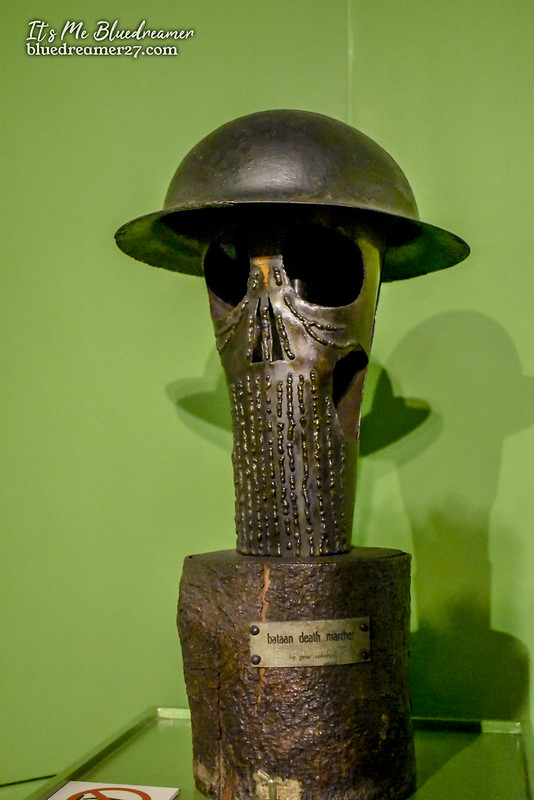
This artwork is not a painting but a sculpture created by the same artist behind the eerie Tragic Lesson painting. Entitled as the “Bataan Death Marcher”, the artwork is a memorabilia of the soldiers who fought for Philippines’ freedom, when they are forced to walk until death by the Japanese soldiers. The Bataan Death Marcher resembles a soldier in a death skull made of metal with a military helmet, supported on a wooden base. It depicts the soldiers suffering from the brutality of the Japanese during the war. Cabrera’s sculpture serves to honor the bravery of the fallen soldiers in defending Bataan.
9. Dama II by Antipas Delotavo
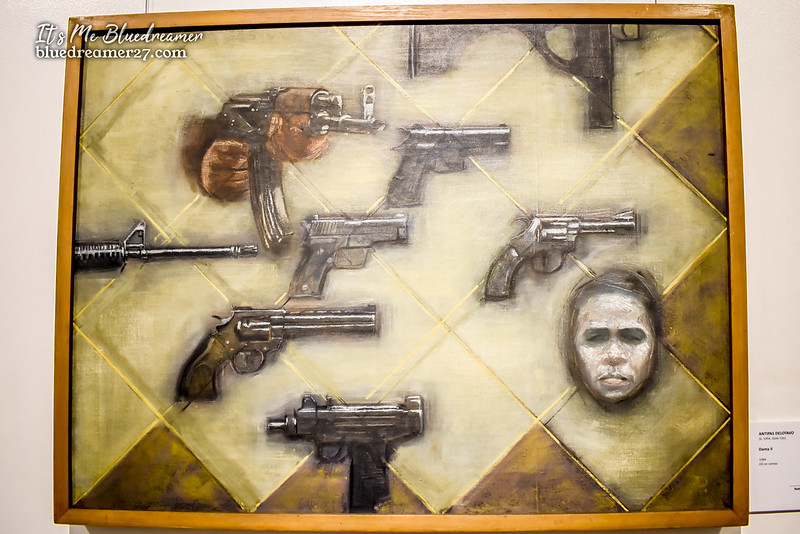
The hallway in the top most floor of the museum features a series of artworks that are considered to be “protest arts”. These are arts that are produced by activists and social movements. One of which includes an artwork known as ‘Dama II” by Antipas Delotavo. Delotavo is a filipino artists that studied at Philippine Women University and was one of the original members of “kaisahan”, the first social realist art movement in the country. Delotavo’s art reveals the harsh realities experienced by the Filipinos.
Dama II depicts assaiult rifles, machine guns and hand guns set in a grid pattern there seems to be a face appearing on the right and a pair of hands holding one of the guns on the left it’s main focus is on guns and the message of violence, pain, and death they bring.
10. Bondage by Papo de Asis
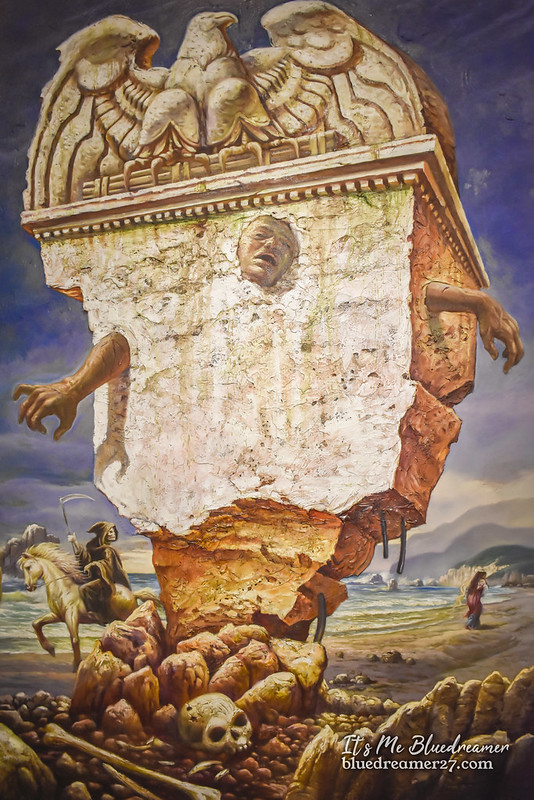 Bondage by Papo de Asis is another Protest art from the same hallway gallery.This artwork was painted in 1993. Papo de Asis became an artist/activist in 1972 when Martial Law was declared. Bondage depicts a man trapped in a concrete structure with an eagle above it. It also shows skull and bones below him. Behind the man is a grim reaper and a running woman. The eagle is said to represent democracy and imperialism.
Bondage by Papo de Asis is another Protest art from the same hallway gallery.This artwork was painted in 1993. Papo de Asis became an artist/activist in 1972 when Martial Law was declared. Bondage depicts a man trapped in a concrete structure with an eagle above it. It also shows skull and bones below him. Behind the man is a grim reaper and a running woman. The eagle is said to represent democracy and imperialism.
The painting somehow depicts a man being imprisoned or enslaved by something much more powerful than him. It could also represent the society that was currently under the martial law at that time where people seeks for their freedom from the Marcos dictatorship.
11. Graveyard Scene by Ricarte Puruganan
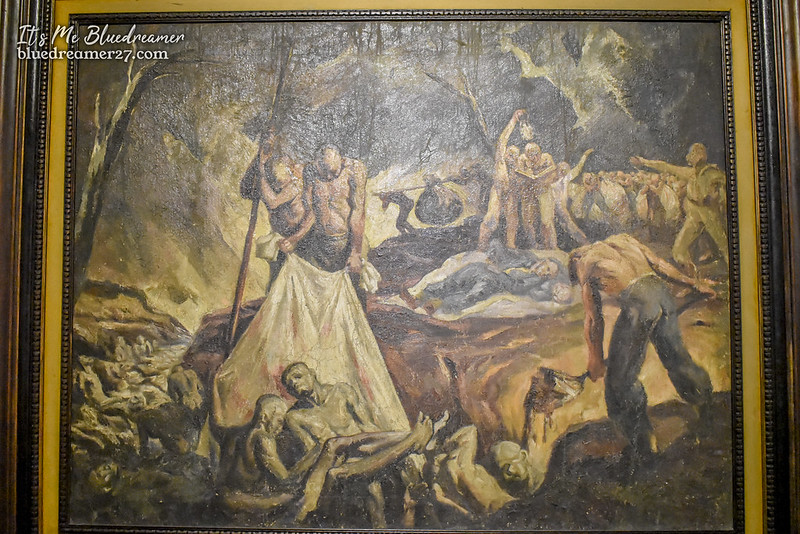
Located in Gallery XIV is another eerie painting. This painting, the Graveyard Scene, is a master piece made by the great painter Ricarte M. Puruganan. The painting depicts a mass burial showing a large number of bodies being buried on the ground. There is also a large number of people behind witnessing the event. Although it is not yet clear but this painting probably depicts the mass burial in Capas, Tarlac which also took place after the Japanese occupation. Ricarte Puruganan also had a painting entitled “Mass Burial of the Heroes at Capas” back in 1944 which was one of finalists in the second National Art Contest held at Escolta Manila, under the auspices of the Japanese sponsored by the Philippine Government, but it was disqualified from the final judgement due to Strong Anti-Japanese Sentiment
Also, feel free to visit my other articles about different National Museums in Manila and other museums in the country.
- A Detailed Tour of National Museum of Fine Arts (2022)
- 30 Items and Galleries You Should Not Miss When Visiting The 3 National Museums in Manila
- 10 Things You Should Not Miss When Visiting The National Museum of Natural History
- A Day in National Museum of Anthropology
- 12 Artworks You Should See At National Museum of Fine Arts
- National Museum of Fine Arts (2016 Visit)
- Mount Samat National Shrine War Museum ~ What To See and What To Expect!
- Revisiting Baldomero Aguinaldo Museum (Museo ni Baldomero Aguinaldo)
- Let’s Explore Museo ng Republika ng 1899 (Barasoain Museum)
- Exploring Ilocos : Crisologo Museum
Sources: Bondage / Aftermath of War / Human Rights and Exhibit Space / Owlcation / Kaisahan/ Ricarte Puruganan

